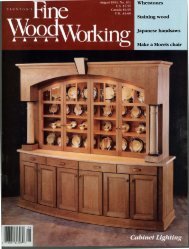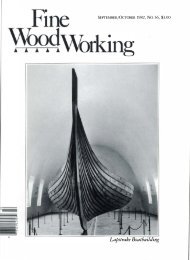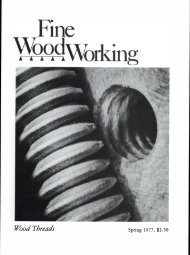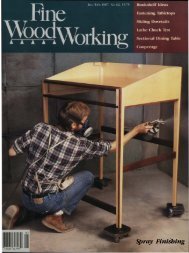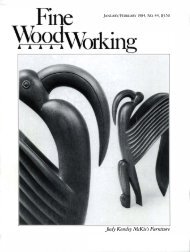NOVEMBER/DECEMBER 1983, No. 43, $3.50 Making ... - Wood Tools
NOVEMBER/DECEMBER 1983, No. 43, $3.50 Making ... - Wood Tools
NOVEMBER/DECEMBER 1983, No. 43, $3.50 Making ... - Wood Tools
You also want an ePaper? Increase the reach of your titles
YUMPU automatically turns print PDFs into web optimized ePapers that Google loves.
· ,<br />
Four lmpowered bed rollers support boards fed through the Makita<br />
2030. Whilejou walk around the machine, stock can be<br />
temporarily shelve on two return rollers on top of the planer.<br />
speeds to develop their rated power. As a result, they are<br />
dangerously noisy (ear protection is a must) and, lacking<br />
torque, they bog down under load. The Makita's 2-HP motor<br />
is fine for most jointing and for planing narrow stock. It<br />
chokes when you try to plane more than Ya2 in. off a wide<br />
board in a single pass. Set aside some time if you're going to<br />
mill a stack of lumber. And figure on cleaning up a mess-the<br />
planer tosses the chips OntO the emerging board, the jointer<br />
leaves them on the floor. I liked the Makita's four adjustable<br />
bed rollers, especially the rwo outboard rollers which prop up<br />
long boards, preventing them from being sniped-gouged too<br />
deeply-as they emerge from the machine. Two return rollers<br />
atop the machine offer a handy perch on which to rest the<br />
board while you walk to the infeed end for another pass.<br />
As a thicknesser, the Makita has great gauges. A plungertype<br />
feeler gauge above the planer infeed table will tell you<br />
how much you're planing off a board before you feed it, and<br />
a nearby placard tells how much of a cut you can take for a<br />
given width without bogging the motor. The thickness indicator,<br />
also a plunger, is calibrated in eighths, reads easily, and<br />
can be set as a stop for repeated cuts to the same thickness.<br />
The jointer gauge (like all the others) is rudimentary at best.<br />
After struggling with the short jointer tables on the overunder<br />
machines, I found it surprisingly easy to accurately<br />
edge-joint a long board on the Makita's 59-in. tables. The<br />
tradeoff, of course, is a 6Ys-in. currerhead that's not very useful<br />
for facing wide, warped stock prior to planing. Supported<br />
at rwo points, the fence is rigid (although mine was warped),<br />
it's movable and it tilts. It has one glaring problem, though.<br />
If it's moved forward, the currerhead is exposed on the back<br />
side. <strong>No</strong>ne of the other machines tested has this hazard.<br />
Setting knives in the Makita is touchy. Instead of fitting<br />
46<br />
When the Makita fence is advanced over the cutter head,<br />
knives are left dangerously exposed as stock is fed.<br />
into slots, the knives are sprung against a squarish cutterhead<br />
by steel clips and held fast by bolted-on, half-round covers.<br />
To adjust the knives, you stick a screwdriver through slots in<br />
the blade covers and pry up on the bottom edge of the knife.<br />
Two small wooden blocks, which span the jointer mouth or<br />
rest on machined surfaces above the planer currerhead, push<br />
the knives to the correct level. Compared to the Inca, this is a<br />
crude arrangement, and it takes lots of trial and error to get<br />
right. The Makita does have one saving grace: the cutterhead<br />
has an external wheel, so you can rotate it by hand, with a<br />
pin to lock it at top dead center.<br />
The Hitachi F-lOOOA, at 320 lb., is the heaviest machine I<br />
tested, and its four steel support columns make it sturdier<br />
than the Makita. Its planer and jointer capacity and running<br />
gear are similar to the Makita's, but the Hitachi lacks the<br />
outboard bed rollers, an annoying shortcoming which I<br />
remedied by mounting my own outfeed roller on a plywood<br />
outrigger. Rollers and castors can be bought from S.H.D.,<br />
PO Box 13P, Sycamore Ave., Medford, Mass. 02 155.<br />
Though Hitachi claims 3 HP for the howling little motor<br />
that powers this machine, I couldn't detect any advantage<br />
over the Makita's claimed 2 HP. As planers, they perform<br />
equally, though the Hitachi is better at chip-handling. Planer<br />
chips are ducted through an oblong chute that exhausts out<br />
the side of the machine. Chips from the jointer are similarly<br />
ducted downward. I fashioned wooden plugs to fit into these<br />
ports, then drilled the plugs to accept the hose from my shop<br />
vacuum. I can run the machine all day without making a<br />
mess, though I have to empty the vacuum frequently.<br />
Hitachi's knife-setting method is quite elegant and nearly<br />
as accurate as Inca's. Like the Makita, the knives are fastened<br />
to a squarish currerhead by bolted-on plates. A detent pin on<br />
the hand wheel locks the currerhead at top dead center. The<br />
knives are spring-loaded, so you just pop them in place and<br />
push them down to height with a couple of magnetic clamps.<br />
They stay put while you tighten the locking bolts.<br />
The Hitachi's cast-iron jointer fence is the best of all the<br />
machines I tested. It's heavy and easy to adjust, and it stays<br />
where you put it. I felt safer using the F- lOOOA, as well. It's<br />
festooned with bright yellow warning stickers, and has little



